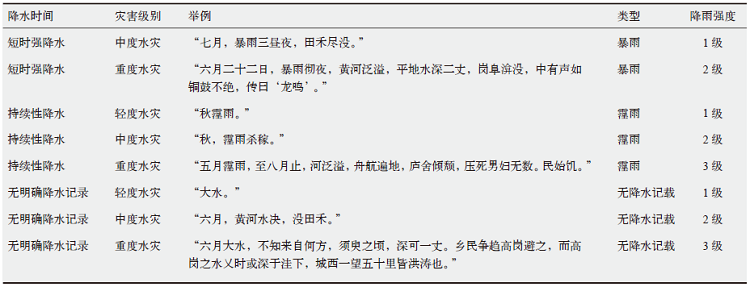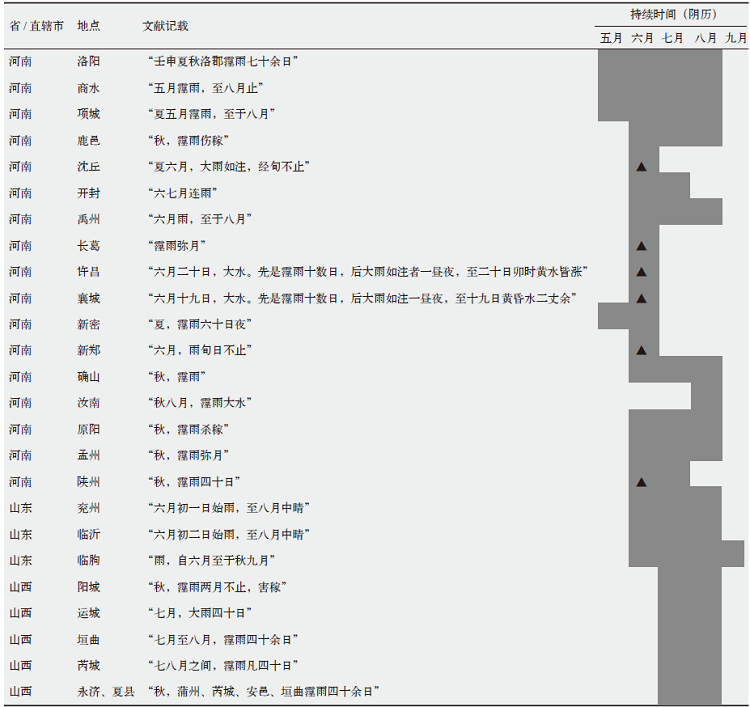Climate Change Research ›› 2024, Vol. 20 ›› Issue (2): 146-157.doi: 10.12006/j.issn.1673-1719.2023.219
• Changes in Climate System • Previous Articles Next Articles
Reconstruction of the 1632 rainstorm and flooding event in North China
LIU Wei( ), YANG Yu-Da(
), YANG Yu-Da( ), ZHANG Sen
), ZHANG Sen
- Center for Historical Geography, Fudan University, Shanghai 200433, China
-
Received:2023-10-07Revised:2023-11-27Online:2024-03-30Published:2024-03-11
Cite this article
LIU Wei, YANG Yu-Da, ZHANG Sen. Reconstruction of the 1632 rainstorm and flooding event in North China[J]. Climate Change Research, 2024, 20(2): 146-157.
share this article
Add to citation manager EndNote|Ris|BibTeX
URL: http://www.climatechange.cn/EN/10.12006/j.issn.1673-1719.2023.219
| [1] | 陶诗言, 丁一汇, 周晓平. 暴雨和强对流天气的研究[J]. 大气科学, 1979, 3 (3): 227-238. |
| Tao S Y, Ding Y H, Zhou X P. The present status of the research on rainstorm and severe convective weathers in China[J]. Chinese Journal of Atmospheric Sciences, 1979, 3 (3): 227-238 (in Chinese) | |
| [2] | 丁一汇. 中国暴雨理论的发展历程与重要进展[J]. 暴雨灾害, 2019, 38 (5): 395-406. |
| Ding Y H. The major advances and development process of the theory of heavy rainfalls in China[J]. Torrential Rain and Disasters, 2019, 38 (5): 395-406 (in Chinese) | |
| [3] | 秦大河. 中国极端天气气候事件和灾害风险管理与适应国家评估报告[M]. 北京: 科学出版社, 2015. |
| Qing D H. China national assessment report on risk management and adaptation of climate extremes and disasters[M]. Beijing: Science Press, 2015 (in Chinese) | |
| [4] | 丁一汇. 论河南“75·8”特大暴雨的研究: 回顾与评述[J]. 气象学报, 2015, 73 (3): 411-424. |
| Ding Y H. On the study of the unprecedented heavy rainfall in Henan province during 4-8 August 1975: review and assessment[J]. Acta Meteorologica Sinica, 2015, 73 (3): 411-424 (in Chinese) | |
| [5] | 汪耀奉. 1860年长江稀遇洪水及其暴雨前期的气候异常[J]. 地理科学, 1982, 2 (4): 368-374. |
|
Wang Y F. The very unexpected flood of the Yangtze River in 1860 and the abnormal climatic phenomena before rainstorm[J]. Scientia Geographica Sinica, 1982, 2 (4): 368-374 (in Chinese)
doi: 10.13249/j.cnki.sgs.1982.04.368 |
|
| [6] | 张家诚. 1823年(清道光三年)我国特大水灾及影响[J]. 应用气象学报, 1993, 4 (3): 379-384. |
| Zhang J C. A preliminary investigation of the floods in 1823 and their socioeconomic impacts in China[J]. Journal of Applied Meteorological Science, 1993, 4 (3): 379-384 (in Chinese) | |
| [7] | 赵会霞, 郑景云, 葛全胜.1755、 1849年苏皖地区重大洪涝事件复原分析[J]. 气象科学, 2004, 24 (4): 460-467. |
| Zhao H X, Zheng J Y, Ge Q S. The reconstruction of 1755 and 1849 severe flood events in Jiangsu and Anhui provinces[J]. Journal of the Meteorological Sciences, 2004, 24 (4): 460-467 (in Chinese) | |
| [8] | 张德二, 陆龙骅. 历史极端雨涝事件研究: 1823年我国东部大范围雨涝[J]. 第四纪研究, 2011, 31 (1): 29-35. |
| Zhang D E, Lu L H. Study of the large extent flooding over eastern China in 1823 as one of the extreme climatic events in history[J]. Quaternary Sciences, 2011, 31 (1): 29-35 (in Chinese) | |
| [9] | 张德二. 1755年中国东部极端雨涝事件研究[J]. 气候变化研究进展, 2012, 8 (1): 1-7. |
| Zhang D E. Study of the large scale flooding over eastern China in 1755: an extreme climatic event in history[J]. Climate Change Research, 2012, 8 (1): 1-7 (in Chinese) | |
| [10] | 张德二, 梁有叶. 1730年夏季黄淮地区暴雨极端事件研究[J]. 气候变化研究进展, 2016, 12 (5): 407-412. |
| Zhang D E, Liang Y Y. Study of the heavy torrential rain over the Huang-Huai region in eastern China in 1730: an extreme climatic events in history[J]. Climate Change Research, 2016, 12 (5): 407-412 (in Chinese) | |
| [11] |
Yang Y D, Xu Z R, Zhen W W, et al. Rain belt and flood peak: a study of the extreme precipitation event in the Yangtze River basin in 1849[J]. Water, 2021, 13 (19): 2677
doi: 10.3390/w13192677 URL |
| [12] | 李卓仑, 董春雨, 杨煜达, 等. 1869年长江中下游地区水灾时空分布及天气特征[J]. 长江流域资源与环境, 2010, 19 (S1): 166-171. |
| Li Z L, Dong C Y, Yang Y D, et al. Characteristics of spatial and temporal flood distribution in middle and lower reaches of the Yangtze River in 1869[J]. Resources and Environment in the Yangtze Basin, 2010, 19 (S1): 166-171 (in Chinese) | |
| [13] | 张健, 满志敏, 张俊辉. 1819年黄河中游极端降水: 史实、特征及气候背景[J]. 古地理学报, 2011, 13 (6): 687-698. |
| Zhang J, Man Z M, Zhang J H. Extreme precipitation in the middle reaches of Yellow River in 1819: historical facts, characteristics and climate background[J]. Journal of Palaeogeography, 2011, 13 (6): 687-698 (in Chinese) | |
| [14] | 马亚玲, 万金红, 叶瑜, 等. 1917年海河流域洪涝灾害过程重建[J]. 古地理学报, 2015, 17 (6): 851-860. |
| Ma Y L, Wan J H, Ye Y, et al. Reconstruction of flood disaster process in Haihe River drainage area in 1917[J]. Journal of Palaeogeography, 2015, 17 (6): 851-860 (in Chinese) | |
| [15] | 张德二. 中国历史极端气候事件复原研究[M]. 北京: 商务印书馆, 2023. |
| Zhang D E. Study on the recovery of historical extreme climate events in China[M]. Beijing: The Commercial Press, 2023 (in Chinese) | |
| [16] | 杨煜达, 韩健夫. 历史时期极端气候事件的甄别方法研究: 以西北千年旱灾序列为例[J]. 历史地理, 2014, 2 (2): 10-29. |
| Yang Y D, Han J F. A study on the diagnosis method of extreme climate events in historical period: a case study of northwest drought Sequence over 1000 years[J]. Historical Geography, 2014, 2 (2): 10-29 (in Chinese) | |
| [17] | 韩健夫, 杨煜达, 满志敏. 公元1000—2000年中国北方地区极端干旱事件序列重建与分析[J]. 古地理学报, 2019, 21 (4): 675-684. |
| Han J F, Yang Y D, Man Z M. Reconstruction and analysis of extreme drought events in northern China from AD 1000 to 2000[J]. Journal of Paleogeography, 2019, 21 (4): 675-684 (in Chinese) | |
| [18] | 刘威, 杨煜达. 过去600年中国西南地区极端旱涝事件的重建与分析[J]. 第四纪研究, 2021, 41 (2): 368-378. |
| Liu W, Yang Y D. Reconstruction and analysis of extreme drought and flood events in Southwest China in the past 600 years[J]. Quaternary Sciences, 2021, 41 (2): 368-378 (in Chinese) | |
| [19] | 张德二. 中国三千年气象记录总集[M]. 南京: 江苏教育出版社, 2013. |
| Zhang D E. A Compendium of Chinese meteorological records of the last 3000 years[M]. Nanjing: Jiangsu Education Press, 2013 (in Chinese) | |
| [20] | “中央研究院历史语言研究所”校印. 明实录附录·崇祯长编[M]. 上海: 上海书店出版社, 1967. |
| “The Institute of Historical and Linguistic Research. Academia Sinica”. Ming shi appendix· Chongzhen long compilation[M]. Shanghai: Shanghai Bookstore Publishing House, 1967 (in Chinese) | |
| [21] | 王铎. 拟山园选集[M]. 中国台北: 台湾学生书局, 1979. |
| Wang D. Selected works of Nishanyuan[M]. Chinese Taipei: Taiwan Student’s Bookstore, 1979 (in Chinese) | |
| [22] | 谭其骧. 中国历史地图集(第7册)元·明时期[M]. 北京: 中国地图出版社, 1982. |
| Tan Q X. Historical atlas of China (Volume 7) Yuan·Ming period[M]. Beijing: China Map Press, 1982 (in Chinese) | |
| [23] | 中央气象局气象科学研究院主编. 中国近五百年旱涝分布图集[M]. 北京: 地图出版社, 1981. |
| Chinese Academy of Meteorological Sciences, China Meteorological Administration. Yearly charts of dryness/wetness in China for the last 500-year period[M]. Beijing: Sino Maps Press, 1981 (in Chinese) | |
| [24] | 杨煜达. 中国千年区域极端旱涝图集[M]. 北京: 中图出版社, 中华地图学社, 2024. |
| Yang Y D. Atlas of extreme droughts and floods in China during the Past Millennium(1000-2020)[M]. Beijing: Zhongtu Publishing House, Chinese Cartographic Society, 2024 (in Chinese) | |
| [25] | 国务院灾害调查组. 河南郑州“7·20”特大暴雨灾害调查报告[R/OL]. 2022 [2022-01-01]. https://www.mem.gov.cn/gk/sgcc/tbzdsgdcbg/202201/P020220121639049697767.pdf. |
| Disaster Investigation Group of the State Council. Investigation report on the “7·20” extraordinarily heavy rainstorm disaster in Zhengzhou, Henan[R/OL]. 2022 [2022-01-01]. https://www.mem.gov.cn/gk/sgcc/tbzdsgdcbg/202201/P020220121639049697767.pdf (in Chinese) | |
| [26] | 冉令坤, 李舒文, 周玉淑, 等. 2021年河南“7·20”极端暴雨动、热力和水汽特征观测分析[J]. 大气科学, 2021, 45 (6): 1366-1383. |
| Ran L K, Li S W, Zhou Y S, et al. Observational analysis of the dynamic, thermal, and water vapor characteristics of the “7·20” extreme rainstorm event in Henan province, 2021[J]. Chinese Journal of Atmospheric Sciences, 2021, 45 (6): 1366-1383 (in Chinese) | |
| [27] | 汪小康, 崔春光, 王婧羽, 等. “21·7”河南特大暴雨水汽和急流特征诊断分析[J]. 气象, 2022, 48 (5): 533-544. |
| Wang X K, Cui C G, Wang J Y, et al. Diagnostic analysis on water vapor and jet characteristics of the July 2021 severe torrential rain in Henan province[J]. Meteorology Monthly, 2022, 48 (5): 533-544 (in Chinese) | |
| [28] | 缪驰远, 韩静雅, 苟娇娇. 中国逐日降水数据集(1961—2022, 0.1˚/0.25 ˚/0.5˚)[R/OL]. 2023 [2023-10-07]. https://cstr.cn/18406.11.Atmos.tpdc.300523 |
| Miao C Y, Han J Y, Gou J J. A daily gridded precipitation dataset based on gauge observations across China’s mainland (1961-2022)[R/OL]. 2023 [2023-10-07]. https://cstr.cn/18406.11.Atmos.tpdc.300523 (in Chinese) | |
| [29] | 中国气象局. 2021年中国气候公报[R/OL]. 2022 [2022-03-01]. https://www.cma.gov.cn/zfxxgk/gknr/qxbg/202203/t20220308_4568477.html. |
| China Meteorological Administration. China climate bulletin 2021[R/OL]. 2022 [2022-03-01]. https://www.cma.gov.cn/zfxxgk/gknr/qxbg/202203/t20220308_4568477.html (in Chinese) | |
| [30] | 王军, 吴迪, 王超杰, 等. “21·7”河南极端降水的远距离台风作用分析[J]. 气象与环境科学, 2022, 45 (2): 75-85. |
| Wang J, Wu D, Wang C J, et al. Analysis on the influence of distance typhoon on the extreme precipitation in July 2021 in Henan[J]. Meteorological and Environmental Sciences, 2022, 45 (2): 75-85 (in Chinese) | |
| [31] | 高川, 陈茂楠, 周路, 等. 2020—2021年热带太平洋持续性双拉尼娜事件的演变[J]. 中国科学: 地球科学, 2022, 52 (12): 2353-2372. |
| Gao C, Chen M N, Zhou L, et al. The 2020-2021 prolonged La Niña evolution in the tropical Pacific[J]. Science China: Earth Sciences, 2022, 55 (12): 2353-2372 (in Chinese) | |
| [32] | Cook E R, Darrigo R D, Anchukaitis K J. ENSO reconstructions from long tree-ring chronologies: unifying the differences? talk presented at a special workshop on reconciling ENSO chronologies for the past 500 years[R]. French Moorea: Polynesia, 2008 |
| [33] |
Gergis J L, Fowler A M. A history of ENSO events since AD 1525: implications for future climate change[J]. Climatic Change, 2009, 92 (3-4): 343-387
doi: 10.1007/s10584-008-9476-z URL |
| [34] | 金祖辉, 陶诗言. ENSO循环与中国东部地区夏季和冬季降水关系的研究[J]. 大气科学, 1999, 23 (6): 663-672. |
| Jin Z H, Tao S Y. A study on the relationships between ENSO cycle and rainfalls during summer and winter in eastern China[J]. Chinese Journal of Atmospheric Sciences, 1999, 23 (6): 663-672 (in Chinese) | |
| [35] | 陈文. El Niño和La Niña事件对东亚冬、夏季风循环的影响[J]. 大气科学, 2002, 26 (5): 595-610. |
| Chen W. Impacts of El Niño and La Niña on the cycle of the East Asian winter and summer monsoon[J]. Chinese Journal of Atmospheric Sciences, 2002, 26 (5): 595-610 (in Chinese) | |
| [36] | 丁一汇. 中国气候[M]. 北京: 科学出版社, 2013. |
| Ding Y H. Climate of China[M]. Beijing: Science Press, 2013 (in Chinese) | |
| [37] | 杨修群, 谢倩, 朱益民, 等. 华北降水年代际变化特征及相关的海气异常型[J]. 地球物理学报, 2005 (4): 789-797. |
| Yang X Q, Xie Q, Zhu Y M, et al. Decadal to interdecadal variability of precipitation in North China and associated atmospheric and oceanic anomaly patterns[J]. Chinese Journal of Geophysics, 2005 (4): 789-797 (in Chinese) | |
| [38] | 王艳姣, 周兵, 司东, 等. 2012年夏季我国降水异常及成因分析[J]. 气象, 2013, 39 (1): 118-122. |
| Wang Y J, Zhou B, Si D, et al. Analysis of rainfall anomalies in China in summer 2012[J]. Meteorology Monthly, 2013, 39 (1): 118-122 (in Chinese) | |
| [39] | 赵琳, 孙林海, 竺夏英, 等. 2021年华北雨季气候特征及华北降水偏多成因初探[J]. 气象与环境科学, 2022, 45 (2): 20-26. |
| Zhao L, Sun L H, Zhu X Y, et al. Climate characteristics of rainy season and causes for more precipitation in North China in 2021[J]. Meteorological and Environmental Sciences, 2022, 45 (2): 20-26 (in Chinese) |
| [1] | . Effect of Climate Change on Meteorological Parameters for Building Energy-Saving Design in Four Cities in North China [J]. Climate Change Research, 2011, 7(6): 407-411. |
| [2] | Xia Jun . Precipitation Change and Drought-Flood Evolution in North China [J]. Climate Change Research, 2008, 4(003): 140-144. |
| [3] | Lisheng HAO . Comparison of Summer Monsoon Rainfall Changes Between North China and India [J]. Climate Change Research, 2007, 03(05): 271-275. |
| Viewed | ||||||
|
Full text |
|
|||||
|
Abstract |
|
|||||









